Satellite Data Services Market Research, 2033
The global satellite data services market size was valued at $11 billion in 2023, and is projected to reach $59.7 billion by 2033, growing at a CAGR of 18.7% from 2024 to 2033.Satellite data service is the process of collecting information about the Earth, gathered by manmade satellites in their orbits. Satellites deliver information about surface and weather changes on the planet. Satellite data services deal with capturing images of Earth or other planets with the assistance of imaging satellites. Utilizing these images for commercial purposes is known as commercial satellite imaging, which includes various applications such as environment monitoring & management, security of energy resources, surveillance of border areas, and mapping of construction projects. In addition, earth imagery is vital in various applications, including infrastructure planning & construction, exploitation of new energy sources, disaster management, green mapping, traffic management, and topographical mapping.
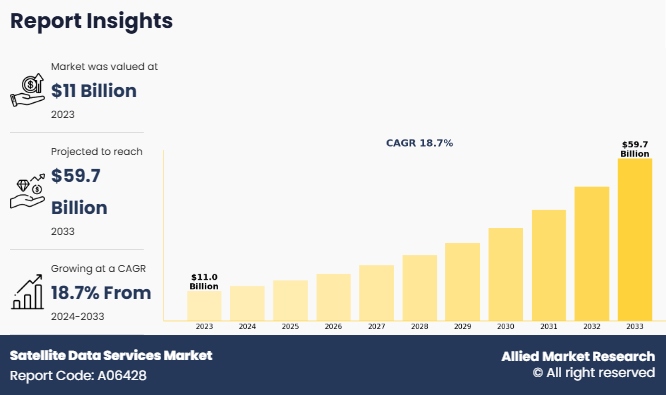
Report Key Highlighters:
- The satellite data services industry study covers 14 countries. The research includes regional and segment analysis of each country in terms of value ($billion) for the projected period 2024-2033.
- The study integrated high-quality data, professional opinions and analysis, and critical independent perspectives. The research approach is intended to provide a balanced view of global markets and to assist stakeholders in making educated decisions to achieve their most ambitious growth objectives.
- Over 3,700 product literature, annual reports, industry statements, and other comparable materials from major industry participants were reviewed to gain a better understanding of the market.
- The key players in the satellite data services industry are Airbus S.A.S., East View Geospatial Inc., ImageSat International, L3Harris Technologies, Inc., Maxar Technologies, Planet Labs Inc., Satellite Imaging Corporation, SpecTIR LLC, Trimble Inc. and Ursa Space Systems Inc. These companies have adopted strategies such as product launches, contracts, expansions, agreements, and others to improve their market positioning.
The most common use for satellite data is in Earth Observation (EO). Moreover, satellite data is widely used in the development of smart cities and connected vehicles. Urban planners use this data to understand settlement trends and ensure efficient infrastructure management.
Factors such as surge in demand for satellite data from various industry verticals, increase in demand for earth observation satellites, and privatization of the space industry are expected to drive satellite data services market growth. However, stringent government regulations for the implementation of satellites and a lack of dedicated launch vehicles for small satellites hinder market growth. Further, increase in adoption of artificial intelligence (AI), machine learning (ML), & cloud computing in the space sector; rise in use of satellite data in the development of smart cities & connected vehicles, and rise in NewSpace movement are expected to offer lucrative opportunities for market expansion.
The satellite data services market is segmented on the basis of vertical, service, end use, and region. On the basis of vertical, the market is divided into energy & power, defense & intelligence, engineering & infrastructure, environmental, agriculture, maritime, insurance, transportation & logistics and others. By service, it is bifurcated into data analytics and image data. On the basis of end-use, it is categorized into commercial and government & military. Region wise, it is studied across North America, Europe, Asia-Pacific, and LAMEA.
Satellite data services are preferred in various applications such as military and agriculture, owing to their accuracy and efficiency. It helps the defense department to monitor activities at border and aids agriculture department in monitoring weather to overcome disasters. In addition, it helps to provide real time data such as transition plan information, fall eclipse information, messaging information, satellite coverage, polar orbit tracks, and general satellite status information. It is widely used in various applications, including geospatial data acquisition & mapping, defense & intelligence, energy, construction & infrastructure development, natural resource management, conservation & research, media & entertainment, surveillance & security, and disaster management.
Key Developments
The leading companies have adopted strategies such as acquisition, agreement, expansion, partnership, contracts, and product launches to strengthen their market position.
- In August 2024, Azercosmos, Azerbaijan's space agency, partnered with the Civil Aviation Authority of Botswana to provide satellite data services through the Azerspace-1 telecommunications satellite. With this collaboration, mBotswana is expected to receive satellite data via the satellite's African C-band coverage for the first time. The agreement aims to enhance Botswana's data capabilities, supporting various applications such as aviation management and communication services.
- In September 2024, Planet Labs Germany GmbH signed a three-year contract with the German Space Agency at the German Aerospace Center (DLR) to provide Earth observation data products and services. This collaboration aims to support research and development initiatives by offering German researchers access to Planet's satellite data. The partnership builds upon a decade-long relationship, with DLR incorporating Planet's data into their research programs since 2009 through the RapidEye Science Archive.
Segmental analysis
The satellite data services market is segmented on the basis of vertical, service, end use, and region. On the basis of vertical, the market is divided into energy & power, defense & intelligence, engineering & infrastructure, environmental, agriculture, maritime, insurance, transportation & logistics and others. By service, it is bifurcated into data analytics and image data. On the basis of end use, it is categorized into commercial and government & military. Region wise, it is studied across North America, Europe, Asia-Pacific, and LAMEA.
By Vertical
By vertical, the global satellite data services market is segmented into energy & power, defense & intelligence, engineering & infrastructure, environmental, agriculture, maritime, insurance, transportation & logistics, and others. The environmental segment accounted for the largest market share in 2023, owing to an increase in implementation and use of earth observation. To keep track of environmental change, governments throughout the world deploy more satellite systems into space. The satellite data services market demand is rising due to the growing need for real-time data in environmental monitoring.
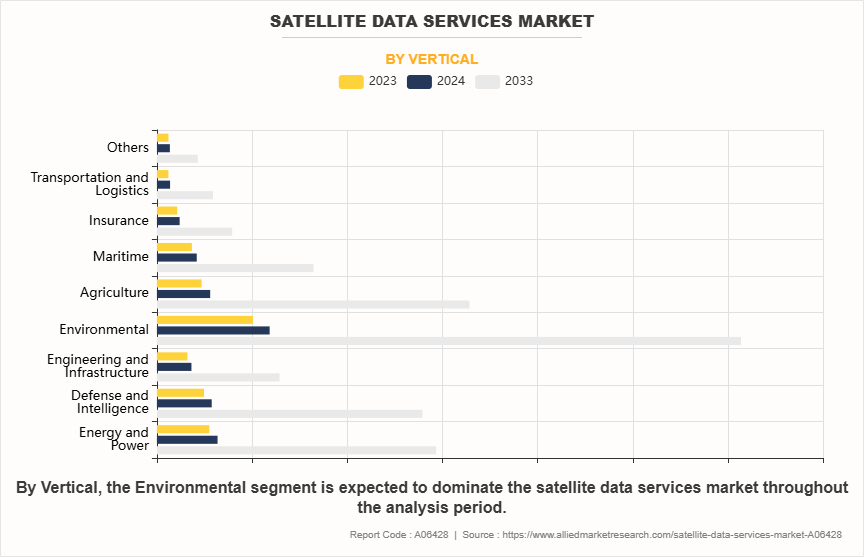
By Service
By service, the global satellite data services market segment is segmented data analytics and image data. The image data segment accounted for the largest market share in 2023, owing to the rise in adoption of location-based services (LBS) by various end-users, including commercial enterprises, government, defense, civil engineering, forestry and agriculture, insurance, and energy.
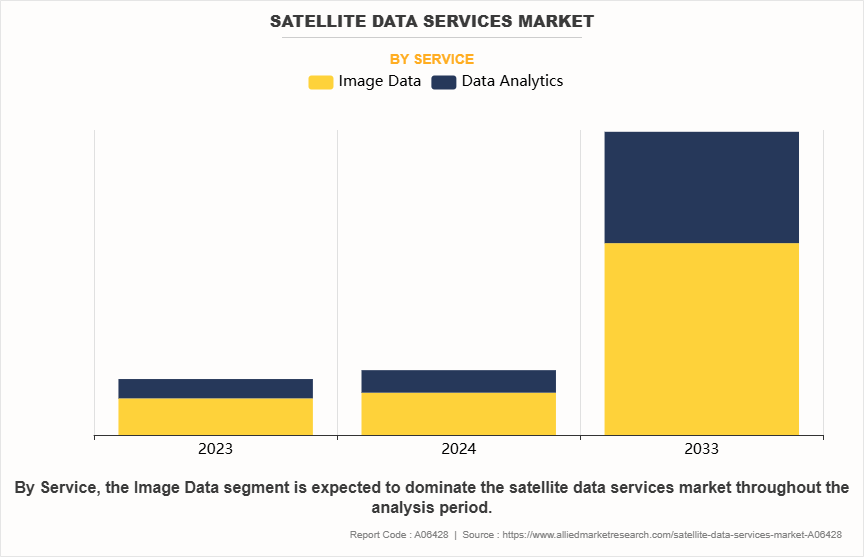
By End Use
By end use, the global satellite data services market is segregated into commercial and government & military. The government & military segment accounted for a dominant market share in 2023, primarily driven by its core applications in military security and surveillance, which are essential for any defense organization. The surge in use of Earth observation satellites has further boosted this segment growth, particularly for defense and security missions as well as government operations. These satellites are increasingly utilized for planning and monitoring activities, enhancing their importance in achieving strategic objectives.
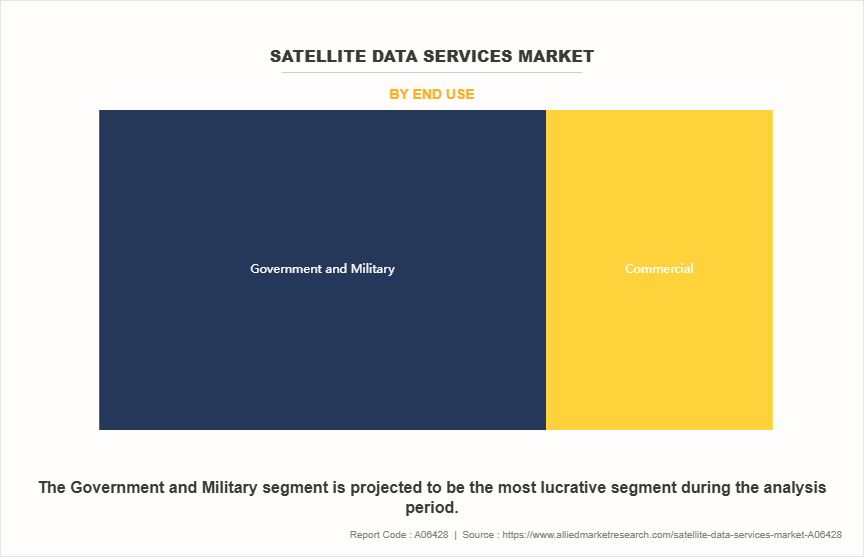
By Region
Region wise, North American held the largest satellite data services market share in 2023, driven by the presence of sophisticated infrastructure to undertake space programs and the earliest & highest adoption of commercial satellite imaging across various industries in the region. Moreover, a substantial increase in space launches in the U.S. by industry leaders such as SpaceX, along with the major North American satellite companies are expected to engage in the development of sophisticated satellite technologies to strengthen the capabilities of satellite data services in this region, boosting the satellite data services market across North America.
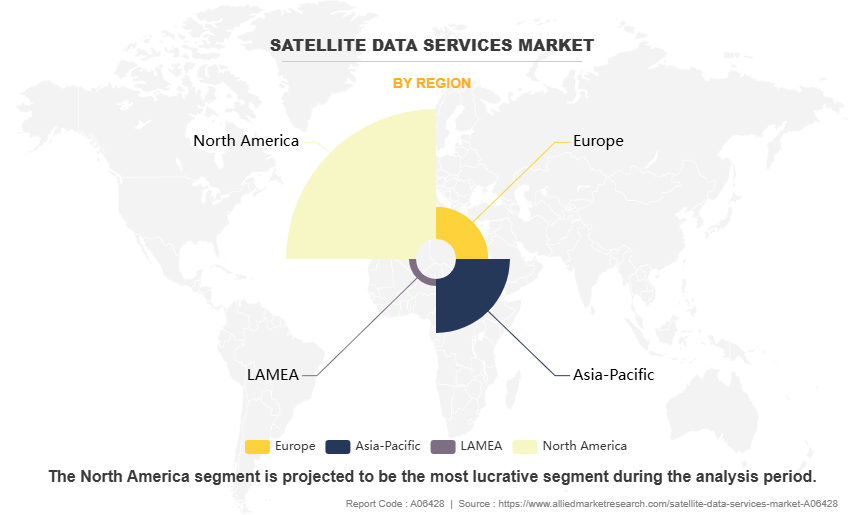
Increase in government focus on development of the space exploration industry
Increased need for satellite data in various industry verticals such as construction, oil & gas, agriculture, mining, and others is projected to help the market grow. The building of infrastructure projects has become more detail oriented with the use of high-resolution satellite images, and the satellite data is expected to give a graphical reference for planners and engineers, resulting in more accuracy in their construction. Similarly, satellite imaging could be used in the mining industry throughout the pre-feasibility and feasibility phases of mineral extraction to obtain data-based information about the mineral possibility of the area in question.
Thus, satellite data services help to store all data and deliver the same to respective operators. Moreover, the rise in unpredictable atmospheric behavior, owing to the rise in global warming increases satellite data services demand in earth observation and disaster management departments. Furthermore, surge in adoption of satellite data for various mapping applications such as Google Earth and Bing Maps, Geographic Information Systems (GIS), oil & mineral exploration, and 3D city models boost the demand for satellite data services. An increase in reliance on satellite data highlights its pivotal role in offering accurate, real-time insights for environmental monitoring and commercial applications. For instance, in November 2024, Mitsubishi Electric Corporation, MUFG Bank, Ltd., Satellite Data Service Corporation, and GHGSat Inc. entered a partnership to utilize satellite data for visualizing greenhouse gas (GHG) emissions and absorption. This collaboration aims to develop a service that offers companies and local governments analyzing information on global GHG emissions, facilitating the monitoring and analysis of emission trends and specific observation points. Thus, the increase in government focus for the development of space exploration industry is anticipated to be the major driving factor for the growth of satellite data services market.
Increase in demand for earth observation satellites
Earth observation satellite is used for non-military applications such as environmental monitoring, meteorology, and map-making. The satellite data services market forecast predicts significant growth, driven by increasing investments in satellite constellations and advanced data analytics. All countries across the globe are very much aware of global warming. These countries take initiatives to reduce or to control it. To reduce global warming, observation of the earth from various perspectives is required.
This rise in focus on monitoring environmental changes and addressing global challenges drives the adoption of advanced satellite data services to provide precise and actionable insights. For instance, in September 2024, NASA awarded a contract to Pixxel, an Indian private spacecraft company specializing in hyperspectral imaging and Earth observation, as part of its $476 million Commercial SmallSat Data Acquisition Program On-Ramp1 Multiple Award. Pixxel is among the eight companies selected to provide Earth-observation data from commercial sources. This initiative aims to support NASA's research and application activities that contribute to enhancing life on Earth.
The satellite constellation is expected to be used to monitor agricultural and forestry environments over wide areas, as well as C-band radar imaging of water resources and other applications. Therefore, there has been an increase in demand for earth observation satellites for such applications, which is expected to propel the growth of the satellite data services market.
Stringent government regulations for implementation and use of satellites
Various government authorities across the globe have imposed stringent regulations on the implementation of commercial satellites to avoid harmful interference of satellite data usage. Moreover, every government authority across the globe has a different regulatory framework related to data collecting, location privacy, intellectual property rights, as well as the use and storage of geospatial data and information, making it difficult for private companies to offer cost-effective and qualitative satellite data services.
In addition, several governments have been regulating satellite-imaging companies, owing to worries about geopolitical adversaries buying images for nefarious purposes and compromising national security. Moreover, there are different regulatory obligations for operators who want to launch satellites such as satellite landing rights, frequency licensing, energy & power licensing, and type approval.
Key Benefits For Stakeholders
- This report provides a quantitative analysis of the market segments, current trends, estimations, and dynamics of the satellite data services market analysis from 2023 to 2033 to identify the prevailing satellite data services market opportunities.
- The market research is offered along with information related to key drivers, restraints, and opportunities.
- Porter's five forces analysis highlights the potency of buyers and suppliers to enable stakeholders make profit-oriented business decisions and strengthen their supplier-buyer network.
- In-depth analysis of the satellite data services market segmentation assists to determine the prevailing market opportunities.
- Major countries in each region are mapped according to their revenue contribution to the global market.
- Market player positioning facilitates benchmarking and provides a clear understanding of the present position of the market players.
- The report includes the analysis of the regional as well as global satellite data services market trends, key players, market segments, application areas, and market growth strategies.
Satellite Data Services Market Report Highlights
| Aspects | Details |
| Forecast period | 2023 - 2033 |
| Report Pages | 280 |
| By Vertical |
|
| By Service |
|
| By End Use |
|
| By Region |
|
| Key Market Players | AIRBUS, Satellite Imaging Corporation, East View Geospatial, Planet Labs Inc., L3Harris Technologies, Inc., Maxar Technologies, ISI (ImageSat International), SpecTIR, Ursa Space Systems Inc., Trimble Inc. |
The upcoming trends of Satellite Data Services Market are increase in adoption of artificial intelligence (AI), machine learning (ML), & cloud computing in the space sector, rise in the use of satellite data in the development of smart cities & connected vehicles, and surge in NewSpace movement
The leading end use of Satellite Data Services Market is government & military
The largest regional market for Satellite Data Services is North America
The global satellite data services market was valued at $11 billion in 2023, and is projected to reach $59.7 billion by 2033, growing at a CAGR of 18.7% from 2024 to 2033.
The key players in the satellite data services market are Airbus S.A.S., East View Geospatial Inc., ImageSat International, L3Harris Technologies, Inc., Maxar Technologies, Planet Labs Inc., Satellite Imaging Corporation, SpecTIR LLC, Trimble Inc. and Ursa Space Systems Inc. These companies have adopted strategies such as product launches, contracts, expansions, agreements, and others to improve their market positioning.
Loading Table Of Content...
Loading Research Methodology...



